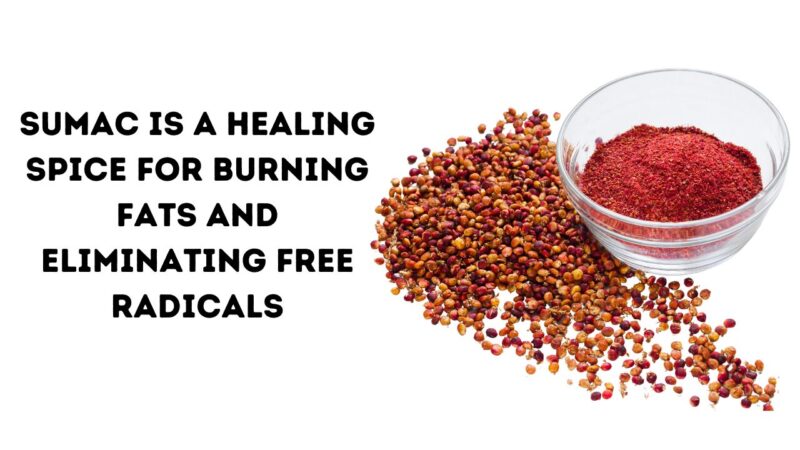Maybe you already know about sumac and even ate it, for example, in an oriental restaurant where it is sprinkled on hummus for flavor and digestive improvement. But it is also used with meat dishes as a marinade and spice, with rice, and put in marinades instead of vinegar. Its sweet and sour taste can be used as a lemon substitute in dishes and soups, and a reddish color can give dishes an appetite-stimulating shade.
Some people believe that sumac is dangerous to health because it is poisonous. Another species of the genus, Toxicodendron fluffy, is called poisonous sumac. Toxicodendron lacquer, or poisonous sumac (lat. Toxicodendron vernix) is a North American shrub or small tree (with white berries while eatable sumac is red). They don’t look like each other, so you don’t have to worry that you’ll buy poisonous sumac.
However, experts warn that low-quality goods, including spices, may contain many impurities added there for weight, for example, similar reddish spices may be added to them. So it is better to buy spices from companies with a high reputation and preferably with quality certificates or laboratory tests from third-party organizations. Organically grown and processed sumac is available for sale and is even certified by government authorities as organic (USDA Organic).
Sumac spice is made from ripe berries of the vinegar tree, which are previously well washed, pressed, and dried. The color of the spice is dark red. Berries for seasoning are harvested at the end of September, soaked, dried, and then ground. This plant grows in the Mediterranean countries, it is especially common in Sicily, Africa, and also in the countries of Central Asia.
However, it turned out that sumac is also a valuable medicinal herb and it can be used for healing purposes. Here are some folk recipes:
How to take sumac for weight loss?
The method of making herbal tea of their sumac for weight loss: pour 1-2 tablespoons of ground sumac into boiling water, brew for 10 minutes, the drink is ready to drink. To reduce the volume of the abdomen after each meal, drink water with the addition of half a teaspoon of sumac. Sumac has antiseptic properties and is often used as a remedy for indigestion. For medical purposes, it plays the role of an antioxidant, ridding the body of unnecessary harmful substances. Sumac contains a huge amount of natural minerals, vitamins, and acids, due to which sumac is able to give your dish a tart and sour taste, pleasant acidity, and aroma. Small portions of this natural antioxidant improve the digestibility of food, replenish vitality and energy reserves.
These abilities were already known in Ancient Rome and in America, where American Indians have always been treated with sumac. Native American sources claim that sumac tincture cleanses the blood from inflammation, unpleasant infections, and parasites. A study of the antifungal properties of sumac has been conducted in regard to the fungal properties of sumac. In Saudi Arabia’s markets, common spices may be contaminated with mycotoxin-producing fungi. However, sumac showed no fungal contamination. It is because sumac has anti-fungal qualities.
Ayurveda, an ancient health science from the Himalayas, has a long history of using berries and sumac leaves. According to Foster & Hobbs (2002) the berries are used as tea in traditional European folk medicine to treat:
- Postpartum bleed
- Bloody discharge
- Urinary tract problems
- Diabetes
- Fever
- Vomiting
- Bed-wetting
- Gargled for ulcerations of mouth and throat
- Externally to wash ringworm lesions and slow healing ulcers
Sumac has a positive effect on the digestive system. It supports liver function, improves digestive processes, accelerates digestion, and eliminates discomfort after eating too much food. It may help with digestive ailments like stomach discomfort, acid reflux, constipation, and irregular bowel movements. Many studies have shown that sumac, like citrus, has antioxidant properties.
The spice helps to get rid of free radicals and therefore prevent all chronic diseases. Due to its antioxidant effect, it protects the brain – one glass of sumac drink per week has a positive effect on the nervous system. Sumac reduces blood sugar and cholesterol. Therefore, it is used to prevent and balance blood sugar and is even called natural insulin. Spices and drinks based on it have healing properties for the treatment of the upper respiratory tract.
Today, the beneficial effects of sumac have been well studied. Regular intake of at least a small pinch of sumac will provide organs and systems with protection:
- from free radicals;
- from inflammation;
- from puffiness;
- from pain due to gout and rheumatism;
- from diarrhea;
- from internal bleeding.
- prevents fat from settling in blood vessels, and normalizes cholesterol levels in the blood.
A high-quality product has a tonic, wound healing, immunomodulatory, diuretic, and strengthening effect, accelerates metabolism and prevents the development of oncology, intoxication with heavy metals, and scurvy.
Warning!
From the search of available literature, sumac has maintained a good track record for safety, with little or no reported adverse effects. However, the fact that sumac belongs to the cashew family Anacardiaceae. People with allergies to those foods may want to take caution in the use of sumac to avoid any potential allergic reactions.
There are some contraindications to the regular use of sumac, such as ulcers, gastritis, or pancreatitis, so you should consult a doctor before using sumac as a dietary supplement or regularly in food.
Calcium Oxalate stones.
Sumac contains a somewhat potent level of oxalic acid that can lead to kidney stones and failure, especially during dry summers when the concentration is higher. It is actually safer to wait a couple of days after it rains when the levels or acid are not as highly concentrated. Also, it is better to boil the liquid after soaking the berries as this will dissipate some of the oxalic acid. So it is better to collect it after rain when it is not very dry and soak in a lot of water.
Extracts contain fewer oxalate stones, so you should prefer extracts. In addition, you can drink magnesium before eating food with oxalates 10-20 minutes before meals. (For capsules 10 minutes and for tablets 20 minutes is required in order to dissolve and begin to remove oxalates). A large number of calcium stones can lead to calcification of blood vessels and organs, as well oxalate stones are known to damage the walls of mitochondria and as other toxins lead to a decrease in its function.
There are many studies on the healing properties of sumac that are published online in PubMed and GreenMedInfo,
- About the benefits of sumac as a nutritional supplement in the treatment of fatty liver
- On monitoring for the prevention of metabolic syndrome
- About the use of sumac as a potent antioxidant
- On increasing the survival rate of patients with rectal cancer with metastases.
Sumac can play a particularly important role in improving the lives of people who have an innate genetic problem of metabolism in the mitochondria of body cells. These diseases are associated with a decrease in the oxidation of fatty acids in the mitochondria of cells and, consequently, a decrease in the production of vital ATP energy. This process is called the beta–oxidation process, and people usually suffer from it from birth. Here is a link to a study on how sumac can improve the oxidation of fatty acids in the mitochondria of liver cells and therefore increase the body’s energy and reduce symptoms of the disease.
Quote: “Free fatty acids (FAs), eicosanoids, and various complex lipids are considered endogenous PPAR ligands. Exogenous ligands are environmental and pharmaceutical molecules that can activate various PPAR family receptors to varying degrees.6, 7, 8, 9 PPARs form a heterodimer with the retinoid X receptor (RXR) after binding to the ligand and bind to response elements that regulate the expression of genes encoding proteins involved in beta oxidation, FA uptake, adipogenesis, and adipocyte differentiation.3, 10, 11, 12 PPAR ligands have emerged as potential therapeutics for nonalcoholic fatty liver disease (NAFLD) (Table 1).”
Quote: ”These compounds have been shown to prevent hepatic tissue from further damage mainly through the following mechanisms:
- reducing fatty acids accumulation in the hepatocytes by down-regulation of sterol regulatory element-binding protein 1c (SREBP-1c), which is involved in the de novo lipogenesis, while up-regulating the Peroxisome proliferator-activated receptor (PPAR)-α, which is responsible for β-fatty acid oxidation;
- improving antioxidant defense enzymes through stimulating the nuclear factor-erythroid 2-related factor 2 (Nrf2), and subsequently reduced oxidative stress; and
- ameliorating the inflammatory responses through the suppression of nuclear factor kappa B (NF-κB) transcription factor and the c-Jun N-terminal kinase (JNK) signaling pathways [11,12]. “
Quote: “PPAR-α involved in energy expenditure could enhance the oxidation of fatty acids by activating the liver-specific carnitine transporter, which is responsible for transporting fatty acids”.
To improve the absorption of sumac and other plants, it is better to use sumac tincture since alcoholic tinctures have the strongest effect on the body and can, as it turned out, work at the cellular level. For those who cannot tolerate alcohol, it is possible to purchase sumac without alcoholic tincture or you can use a water bath to evaporate alcohol from the tincture. Tinctures are sumac extract that is, they contain fewer oxalate stones than spices or tea.
Recommended brands that use proven herbs and standard-compliant procedures for the manufacture of tinctures are HawaiiPharm and HerbalTerra. You can purchase alcoholic and non-alcoholic tinctures from them with a discount in quantity.
HerbalTerra website: https://midly.in/EGmAe8
HawaiiPharm website:
- With alcohol: https://rb.gy/fmyckr
- No alcohol: https://rb.gy/j9dz2b
Please share your experience of using tinctures and spices with us. It will be useful for a little research on the effect of sumac for various health problems.
#Sumac, #fat metabolism, #antioxidant, #Fatty Acid Oxidation Disorder, #digestion support, #sumac tincture, #weight loss, #diabetes support, #abdominal fat, #colorectal cancer, #fatty liver, #NAFLD, #beta oxidation, #mitochondria, #energy, #fatigue, #anti-fungal supplement, #infections, #metabolic syndrome
The information in the article should not be considered medical advice. The information is educational and does not meant to treat, diagnose, prescribe or cure any ailment. Always check with your physician before taking any products or following any advice you have read.




